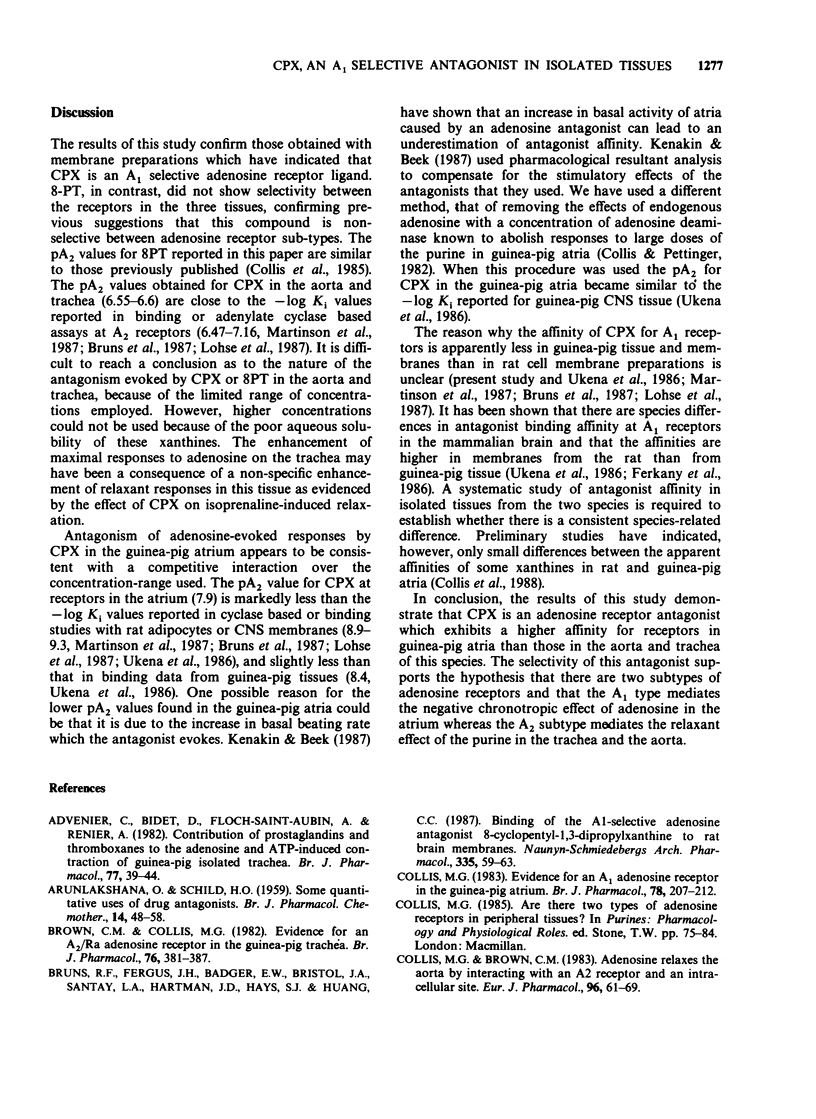Abstract
1. The classification of adenosine receptor subtypes (A1 and A2) in intact tissues has been based on the order of agonist potency. In this study the apparent affinity of 1,3-dipropyl-8-cyclopentylxanthine (CPX), an antagonist which has been reported to be A1 selective, and the non-selective antagonist 1,3-dimethyl-8-phenylxanthine (8PT) has been evaluated on isolated tissues from the guinea-pig. 2. The isolated tissues used were atria (bradycardic response, proposed A1 sub-type), aorta and trachea (relaxant response, proposed A2 sub-type). 3. Both the xanthines antagonized responses to adenosine in the three tissues but had little or no effect on responses to carbachol (atria), sodium nitrite (aorta) or isoprenaline (trachea). 4. pA2 values for 8PT were similar on the three tissues (6.3-6.7), however, the pA2 value for CPX on the atria (7.9-8.4) was greater than that on the aorta (6.6) or trachea (6.6). 5. These results support the suggestion that the adenosine receptors which mediate bradycardia in the atrium are of the A1 sub-type and that those which mediate relaxation in the aorta and trachea are of the A2 type.
Full text
PDF




Selected References
These references are in PubMed. This may not be the complete list of references from this article.
- ARUNLAKSHANA O., SCHILD H. O. Some quantitative uses of drug antagonists. Br J Pharmacol Chemother. 1959 Mar;14(1):48–58. doi: 10.1111/j.1476-5381.1959.tb00928.x. [DOI] [PMC free article] [PubMed] [Google Scholar]
- Advenier C., Bidet D., Floch-Saint-Aubin A., Renier A. Contribution of prostaglandins and thromboxanes to the adenosine and ATP-induced contraction of guinea-pig isolated trachea. Br J Pharmacol. 1982 Sep;77(1):39–44. doi: 10.1111/j.1476-5381.1982.tb09266.x. [DOI] [PMC free article] [PubMed] [Google Scholar]
- Brown C. M., Collis M. G. Evidence for an A2/Ra adenosine receptor in the guinea-pig trachea. Br J Pharmacol. 1982 Jul;76(3):381–387. doi: 10.1111/j.1476-5381.1982.tb09231.x. [DOI] [PMC free article] [PubMed] [Google Scholar]
- Bruns R. F., Fergus J. H., Badger E. W., Bristol J. A., Santay L. A., Hartman J. D., Hays S. J., Huang C. C. Binding of the A1-selective adenosine antagonist 8-cyclopentyl-1,3-dipropylxanthine to rat brain membranes. Naunyn Schmiedebergs Arch Pharmacol. 1987 Jan;335(1):59–63. doi: 10.1007/BF00165037. [DOI] [PubMed] [Google Scholar]
- Collis M. G., Brown C. M. Adenosine relaxes the aorta by interacting with an A2 receptor and an intracellular site. Eur J Pharmacol. 1983 Dec 9;96(1-2):61–69. doi: 10.1016/0014-2999(83)90529-0. [DOI] [PubMed] [Google Scholar]
- Collis M. G. Evidence for an A1-adenosine receptor in the guinea-pig atrium. Br J Pharmacol. 1983 Jan;78(1):207–212. doi: 10.1111/j.1476-5381.1983.tb09381.x. [DOI] [PMC free article] [PubMed] [Google Scholar]
- Collis M. G., Jacobson K. A., Tomkins D. M. Apparent affinity of some 8-phenyl-substituted xanthines at adenosine receptors in guinea-pig aorta and atria. Br J Pharmacol. 1987 Sep;92(1):69–75. doi: 10.1111/j.1476-5381.1987.tb11297.x. [DOI] [PMC free article] [PubMed] [Google Scholar]
- Collis M. G., Palmer D. B., Saville V. L. Comparison of the potency of 8-phenyltheophylline as an antagonist at A1 and A2 adenosine receptors in atria and aorta from the guinea-pig. J Pharm Pharmacol. 1985 Apr;37(4):278–280. doi: 10.1111/j.2042-7158.1985.tb05063.x. [DOI] [PubMed] [Google Scholar]
- Collis M. G., Pettinger S. J. Can ATP stimulate P1-receptors in guinea-pig atrium without conversion to adenosine? Eur J Pharmacol. 1982 Jul 30;81(4):521–529. doi: 10.1016/0014-2999(82)90341-7. [DOI] [PubMed] [Google Scholar]
- Farmer S. G., Hay D. W., Raeburn D., Fedan J. S. Relaxation of guinea-pig tracheal smooth muscle to arachidonate is converted to contraction following epithelium removal. Br J Pharmacol. 1987 Sep;92(1):231–236. doi: 10.1111/j.1476-5381.1987.tb11316.x. [DOI] [PMC free article] [PubMed] [Google Scholar]
- Haleen S. J., Steffen R. P., Hamilton H. W. PD 116,948, a highly selective A1 adenosine receptor antagonist. Life Sci. 1987 Feb 9;40(6):555–561. doi: 10.1016/0024-3205(87)90369-9. [DOI] [PubMed] [Google Scholar]
- Hamel E., Edvinsson L., MacKenzie E. T. Heterogeneous vasomotor responses of anatomically distinct feline cerebral arteries. Br J Pharmacol. 1988 Jun;94(2):423–436. doi: 10.1111/j.1476-5381.1988.tb11544.x. [DOI] [PMC free article] [PubMed] [Google Scholar]
- Kenakin T. P., Beek D. Measurement of antagonist affinity for purine receptors of drugs producing concomitant phosphodiesterase blockade: the use of pharmacologic resultant analysis. J Pharmacol Exp Ther. 1987 Nov;243(2):482–486. [PubMed] [Google Scholar]
- Lohse M. J., Klotz K. N., Lindenborn-Fotinos J., Reddington M., Schwabe U., Olsson R. A. 8-Cyclopentyl-1,3-dipropylxanthine (DPCPX)--a selective high affinity antagonist radioligand for A1 adenosine receptors. Naunyn Schmiedebergs Arch Pharmacol. 1987 Aug;336(2):204–210. doi: 10.1007/BF00165806. [DOI] [PubMed] [Google Scholar]
- Martinson E. A., Johnson R. A., Wells J. N. Potent adenosine receptor antagonists that are selective for the A1 receptor subtype. Mol Pharmacol. 1987 Mar;31(3):247–252. [PubMed] [Google Scholar]
- Ukena D., Jacobson K. A., Padgett W. L., Ayala C., Shamim M. T., Kirk K. L., Olsson R. O., Daly J. W. Species differences in structure-activity relationships of adenosine agonists and xanthine antagonists at brain A1 adenosine receptors. FEBS Lett. 1986 Dec 1;209(1):122–128. doi: 10.1016/0014-5793(86)81096-1. [DOI] [PMC free article] [PubMed] [Google Scholar]
- van Calker D., Müller M., Hamprecht B. Adenosine regulates via two different types of receptors, the accumulation of cyclic AMP in cultured brain cells. J Neurochem. 1979 Nov;33(5):999–1005. doi: 10.1111/j.1471-4159.1979.tb05236.x. [DOI] [PubMed] [Google Scholar]


